because there are rules - trying to keep things a wee bit scientific here, folks!
1. You have to be travelling. On the bus, in a car, in a traffic jam. Watching out of the window doesn't count (Mum, I'm looking at you! The yellow car you can see out of the back window doesn't count!)You need to be on a journey.
2. Parked cars only count once. If you see a parked car - and you can count dealerships - you can count it, but if you pass the same car again on the way back, you can't count it.
3. You can't count cars/vans which are wearing yellow as livery. (This is where lorries are left out) If a van/car is yellow because (for example) it belongs to the Council, it doesn't count. Plain yellow vans with lights on the roof don't count. If it looks as if it is yellow as a matter of happenstance, it's OK.
Taxis which are yellow do count, as long as it isn't the entire fleet - look and ye shall learn!
4. Gold doesn't count - it's metallic beige. If you see a metallic yellow, you will know!
Happy hunting!
Wednesday, 17 December 2008
Saturday, 6 December 2008
I Am Curious about Yellow...
Cars, that is...
OK. It began when I was heading south, and being bored, started to count 'Unsuitably Coloured Cars' as a diversion. Well they are out there... puke green, blood stain red, deep bruise purple (the last branded as 'Envy' - dear gods, what colour do they paint the adultery version??) And in the midst of things came the yellow cars.
So I started counting precisely how many 'orrible coloured vehicles I saw on a journey. But in doing so I became very aware of yellow. Not gold - it's just metallic beige, in most cases. (There is one variety that is metallic yellow - you know it when you see it.)There were a lot of yellow cars around - or was it just my perception? They ARE obvious, after all. And (as an aside) some are better than others... a yellow Mini is cute. A yellow Volvo looks like a travelling slab of butter. And it depends very much on the shade of yellow. A pale yellow Fiat looks OK. A saffron yellow Citroen looks ... hell, just weird. (And, as a disturbing aside, there are suddenly more orange Fords around... are the damn things ripening??)
And then I drove down to Mum's place and a wee while later, went to visit a friend in Nottingham (hi Tats!). And on the way, I counted the yellow cars. As you do... (to quote Richard Hammond).
From home to Mum - 420 miles. Yellow cars - 41. (1:10(ish))
From Mum's to Tats' - 100 miles - 20 cars. (1:5) and the traffic was MUCH busier.
Which made me wonder.
(a)Is there any correlation between traffic density and the number of yellow cars you see on the journey?
(b)Is the distribution of yellow cars significant? Do they exhibit any migratory pattern - are they urban or rural - can I find any correlation?
So I've been counting yellow cars... and (so far) it's proving interesting (although I ain't sure it's a statistically sound analysis, so don't kick me yet!).. on 'average' rural + urban roads (eg, from home to Aberdeen and back, or on my way to work - sampled over 3 months)I get an average of 1 yellow car per 10 miles. So I'm taking this as the baseline figure. Anything more means busy traffic, anything less means quiet-ish. OK, if I was being very scientific, I'd break it down to urban and rural (and I'm trying to find out how I can do that sensibly and safely - at the moment I just click a mechanical counter when I see one and check the mileage at the end of the trip..)
And so far, the (a) theory is holding up.
And there are odd features that support the (b) theory...vis:
Yellow cars are an urban species.
Yellow cars prefer daylight - ie. they are diurnal - and on the whole are more commonly seen when the weather is warm.
Yellow cars are biassed towards the East coast. (Have they migrated in from the Continent?)
Yellow cars are - on the whole - clean... I've only seen one dirty one in six months.
The study continues - made more difficult by the onset of early dark - with sodium lighting, it becomes harder to pick out definite yellows - but I'm still recording cars seen per miles (visible).
And once in a while, you get a perfect 'yellow car moment'... at a roundabout in Aberdeen, I saw a primrose-yellow small Peugeot approach a roundabout. From the opposite direction came an identical primrose-yellow Peugeot. They hit the roundabout at the same precise moment, and passing, exited from opposite roads. Synchronised yellow.
Bliss!
I'll keep you posted...
OK. It began when I was heading south, and being bored, started to count 'Unsuitably Coloured Cars' as a diversion. Well they are out there... puke green, blood stain red, deep bruise purple (the last branded as 'Envy' - dear gods, what colour do they paint the adultery version??) And in the midst of things came the yellow cars.
So I started counting precisely how many 'orrible coloured vehicles I saw on a journey. But in doing so I became very aware of yellow. Not gold - it's just metallic beige, in most cases. (There is one variety that is metallic yellow - you know it when you see it.)There were a lot of yellow cars around - or was it just my perception? They ARE obvious, after all. And (as an aside) some are better than others... a yellow Mini is cute. A yellow Volvo looks like a travelling slab of butter. And it depends very much on the shade of yellow. A pale yellow Fiat looks OK. A saffron yellow Citroen looks ... hell, just weird. (And, as a disturbing aside, there are suddenly more orange Fords around... are the damn things ripening??)
And then I drove down to Mum's place and a wee while later, went to visit a friend in Nottingham (hi Tats!). And on the way, I counted the yellow cars. As you do... (to quote Richard Hammond).
From home to Mum - 420 miles. Yellow cars - 41. (1:10(ish))
From Mum's to Tats' - 100 miles - 20 cars. (1:5) and the traffic was MUCH busier.
Which made me wonder.
(a)Is there any correlation between traffic density and the number of yellow cars you see on the journey?
(b)Is the distribution of yellow cars significant? Do they exhibit any migratory pattern - are they urban or rural - can I find any correlation?
So I've been counting yellow cars... and (so far) it's proving interesting (although I ain't sure it's a statistically sound analysis, so don't kick me yet!).. on 'average' rural + urban roads (eg, from home to Aberdeen and back, or on my way to work - sampled over 3 months)I get an average of 1 yellow car per 10 miles. So I'm taking this as the baseline figure. Anything more means busy traffic, anything less means quiet-ish. OK, if I was being very scientific, I'd break it down to urban and rural (and I'm trying to find out how I can do that sensibly and safely - at the moment I just click a mechanical counter when I see one and check the mileage at the end of the trip..)
And so far, the (a) theory is holding up.
And there are odd features that support the (b) theory...vis:
Yellow cars are an urban species.
Yellow cars prefer daylight - ie. they are diurnal - and on the whole are more commonly seen when the weather is warm.
Yellow cars are biassed towards the East coast. (Have they migrated in from the Continent?)
Yellow cars are - on the whole - clean... I've only seen one dirty one in six months.
The study continues - made more difficult by the onset of early dark - with sodium lighting, it becomes harder to pick out definite yellows - but I'm still recording cars seen per miles (visible).
And once in a while, you get a perfect 'yellow car moment'... at a roundabout in Aberdeen, I saw a primrose-yellow small Peugeot approach a roundabout. From the opposite direction came an identical primrose-yellow Peugeot. They hit the roundabout at the same precise moment, and passing, exited from opposite roads. Synchronised yellow.
Bliss!
I'll keep you posted...
Saturday, 22 November 2008
Loch & Awe
Autumn, changing colours and the hint of oncoming winter.... what do you do? Sounds like a good time to take a break, relax and go on holiday, which is what Mum and I did in October. Some years ago we went to a Forestry Commission site at Loch Awe, which got sold off - this year we found that some of the cabins were again for rent - (have a look here) - so we decided to go back, and so glad we did!
This is the cabin, overlooking the loch....
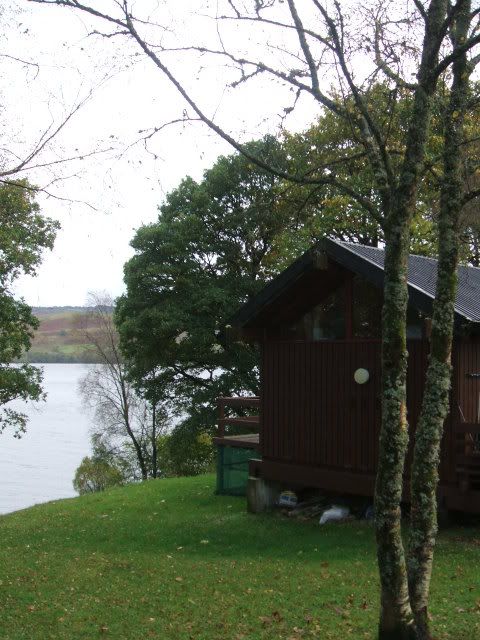
It's compact, cosy, very reasonably priced, and fully heated!
We didn't expect the weather to be good - and were not disappointed - it chucked it down on a regular basis - when we woke up, the loch was usually calm and still, the wind picked up during the day becoming quite fierce by nightfall. Nevertheless, one morning I woke to the sound of thunder so loud that I thought it was blasting at a nearby quarry - the blast reverberated through me as I lay in my bunk, and the sound of the rain on the roof was deafening! But the cabin was snug, and we had a great deal of pleasure just watching the rain, and the loch rising...at least a foot during the week...
We put out bird-feeders, as we'd done in the past, (and had on one visit attracted a pine marten)and were soon discovered by the locals - I don't think I've ever seen so many coal tits, chaffinches, great tits, and blue tits - who soon proceeded to eat us out of house and home....
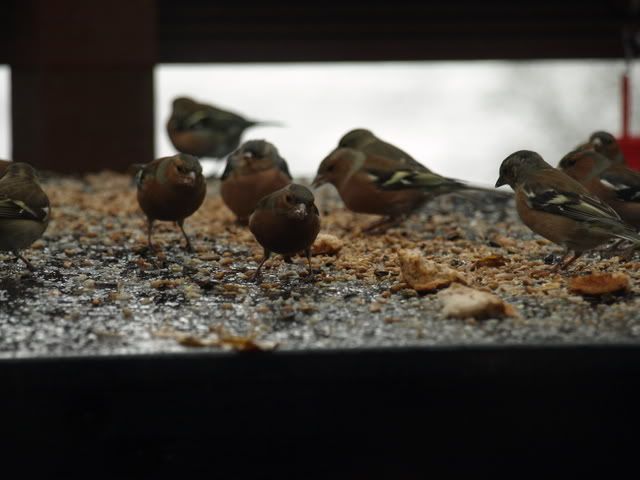
There were also siskins, a wren, and a robin who appeared to be the only vegetarian robin I've ever encountered - we got in some mealworms for him which were studiously ignored in favour of breadcrumbs..
The most striking visitor to the feeders was a red squirrel, who appeared on the second day, and then came back every day - several times a day on occasion. The peanuts were the main focus of his attention, but he paid visits to the sunflower seeds, and checked out the whole deck in case he'd missed something.



The weather meant we stayed in the cabin quite a lot - which was excellent, as it meant we got to see all the visitors - but we still managed to get out and about on a few occasions - through Kilmartin Glen with its standing stones and burial mounds (the ancient heart of the kingdom of Dalriada) down to Crinan - across the Moine Mhor (Great Bog) Nature Reserve
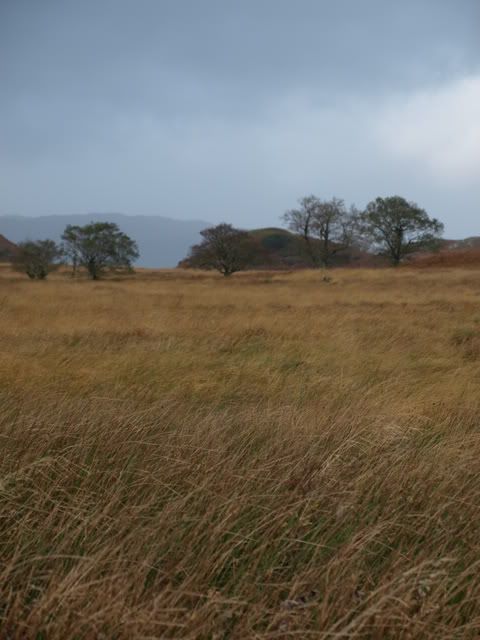
...and the Canal itself, with the huge locks that connect the inner loch to the sea and formed the basis for much of the trade in the early part of the 20th century - the heart of 'Para Handy' country.

We went down through the islands to Seil and Easdale (and managed to flatten the car battery by leaving the lights on whilst having lunch!)where the wind was whipping the sea up.
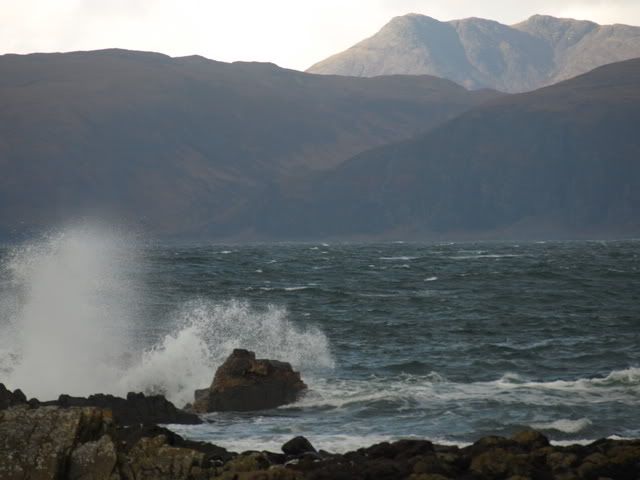
We stayed at the cabin for a week - utterly relaxing, quite enchanting, and rather soggy! Wet, mossy forests, sudden storms, and the glorious reds, golds and bronzes of autumn bracken and leaves. We came home through some of the wettest weather - floods in Oban and the higher end of Speyside round Laggan, where the autumn colours were still developing.
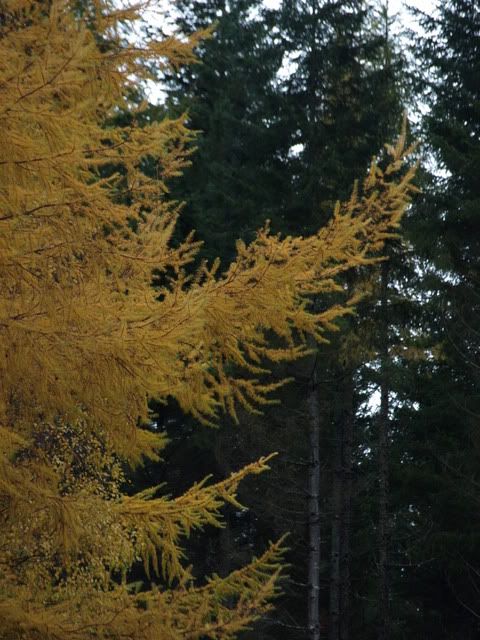
The trees were thick with lichen - a good indicator of clean air, and strange in its own right...

We side-tracked towards the headwaters of the Spey (defeated by floods) but paused at this old house, before finally heading for home, and fish and chips.
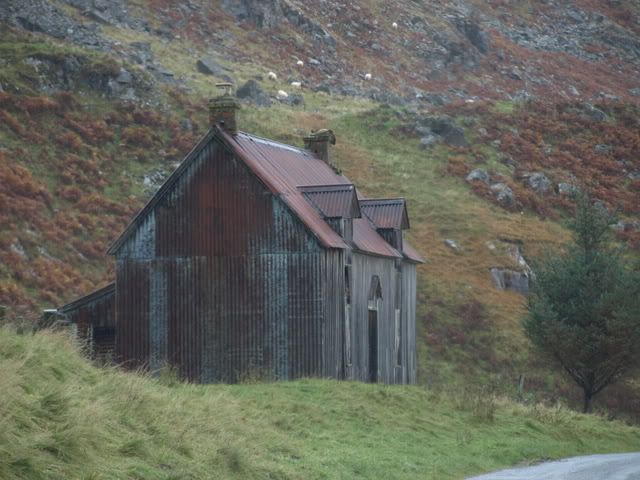
Loch Awe....Wet it may have been, but I'd utterly recommend it as an out-of-the way spot for relaxation!
This is the cabin, overlooking the loch....

It's compact, cosy, very reasonably priced, and fully heated!
We didn't expect the weather to be good - and were not disappointed - it chucked it down on a regular basis - when we woke up, the loch was usually calm and still, the wind picked up during the day becoming quite fierce by nightfall. Nevertheless, one morning I woke to the sound of thunder so loud that I thought it was blasting at a nearby quarry - the blast reverberated through me as I lay in my bunk, and the sound of the rain on the roof was deafening! But the cabin was snug, and we had a great deal of pleasure just watching the rain, and the loch rising...at least a foot during the week...
We put out bird-feeders, as we'd done in the past, (and had on one visit attracted a pine marten)and were soon discovered by the locals - I don't think I've ever seen so many coal tits, chaffinches, great tits, and blue tits - who soon proceeded to eat us out of house and home....

There were also siskins, a wren, and a robin who appeared to be the only vegetarian robin I've ever encountered - we got in some mealworms for him which were studiously ignored in favour of breadcrumbs..
The most striking visitor to the feeders was a red squirrel, who appeared on the second day, and then came back every day - several times a day on occasion. The peanuts were the main focus of his attention, but he paid visits to the sunflower seeds, and checked out the whole deck in case he'd missed something.



The weather meant we stayed in the cabin quite a lot - which was excellent, as it meant we got to see all the visitors - but we still managed to get out and about on a few occasions - through Kilmartin Glen with its standing stones and burial mounds (the ancient heart of the kingdom of Dalriada) down to Crinan - across the Moine Mhor (Great Bog) Nature Reserve

...and the Canal itself, with the huge locks that connect the inner loch to the sea and formed the basis for much of the trade in the early part of the 20th century - the heart of 'Para Handy' country.

We went down through the islands to Seil and Easdale (and managed to flatten the car battery by leaving the lights on whilst having lunch!)where the wind was whipping the sea up.

We stayed at the cabin for a week - utterly relaxing, quite enchanting, and rather soggy! Wet, mossy forests, sudden storms, and the glorious reds, golds and bronzes of autumn bracken and leaves. We came home through some of the wettest weather - floods in Oban and the higher end of Speyside round Laggan, where the autumn colours were still developing.

The trees were thick with lichen - a good indicator of clean air, and strange in its own right...

We side-tracked towards the headwaters of the Spey (defeated by floods) but paused at this old house, before finally heading for home, and fish and chips.

Loch Awe....Wet it may have been, but I'd utterly recommend it as an out-of-the way spot for relaxation!
Wednesday, 1 October 2008
A'Broad - day ten to the end....
Day Ten: Hickling to Barton Turf: a lot of today was spent waiting for the tide to fall far enough to get under the Potter Heigham bridge!!! Had to fill up with as much water as we could, and the pilot was planning to get extra manpower to weigh the boat down if needed... as it was we went through at full speed, heads ducked low and cleared it by about 2 inches... Moored up at a point about 30 minutes from the boatyard, to return in time the following day. (my only mooring manoeuvre! I actually did it, after all this time!)
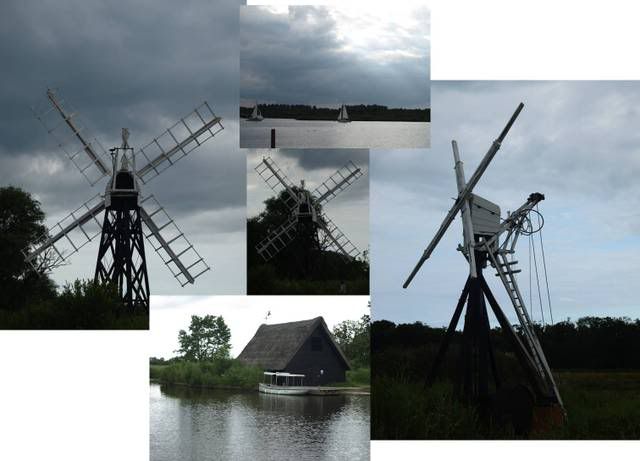
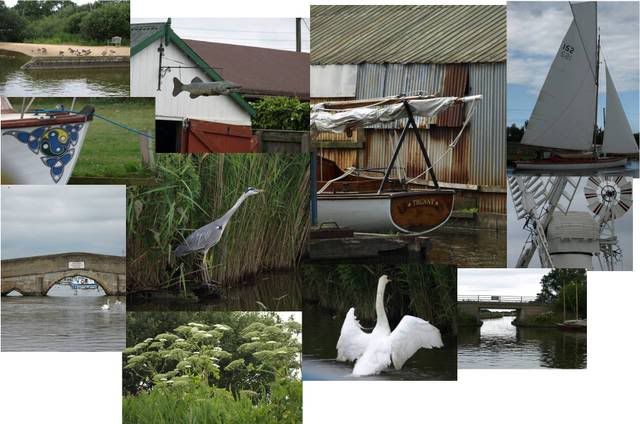
Day Eleven: from Barton Turf to returning the boat at Stalham. I'm very glad we didn't do this at the weekend, given how busy the boatyard was.....
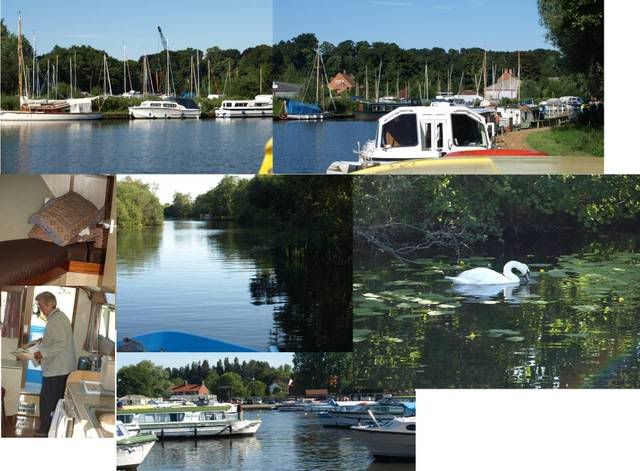
We had fun.... I think we managed to cover just about all the Broads - at least as far as we could given the size limitations of the boat - and maybe we pushed the envelope a bit there too! Glorious scenery, wonderful wildlife, and the weather wasn't bad, except that it chose to rain whenever we had to take the screen and canopy down to go through a low bridge!
a Googlemap of our travels is here.


Day Eleven: from Barton Turf to returning the boat at Stalham. I'm very glad we didn't do this at the weekend, given how busy the boatyard was.....

We had fun.... I think we managed to cover just about all the Broads - at least as far as we could given the size limitations of the boat - and maybe we pushed the envelope a bit there too! Glorious scenery, wonderful wildlife, and the weather wasn't bad, except that it chose to rain whenever we had to take the screen and canopy down to go through a low bridge!
a Googlemap of our travels is here.
A'Broad - day seven to nine.....
Day Seven: Berney Arms to Potter Heigham, which involves going across Breydon Water again, through Yarmouth, and up the River Thurne. Potter Heigham has a Very Low Bridge, so we waited til the next day to go through.
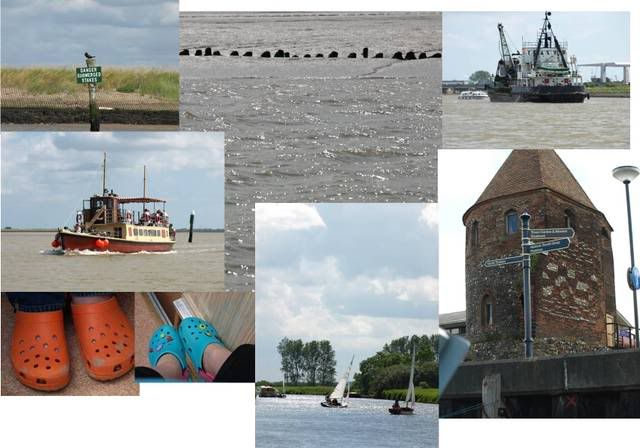
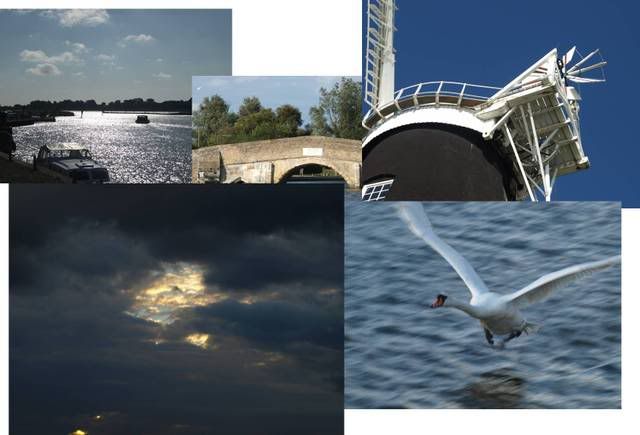
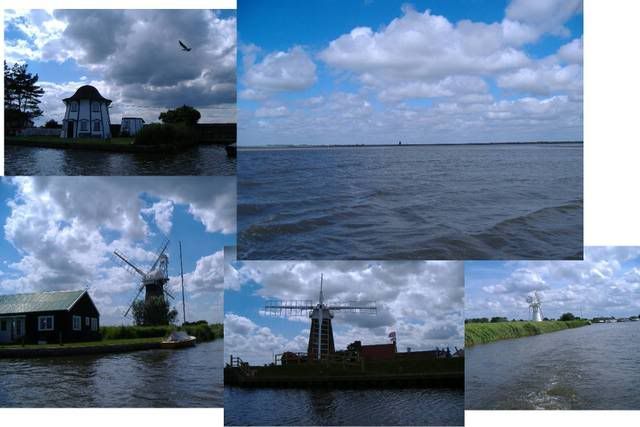
Day Eight: Potter Heigham to Horsey Mill. The pilot has to take you through the bridge, which is quite a relief, given the low clearance.... Horsey Mill is National Trust - shore party went exploring!
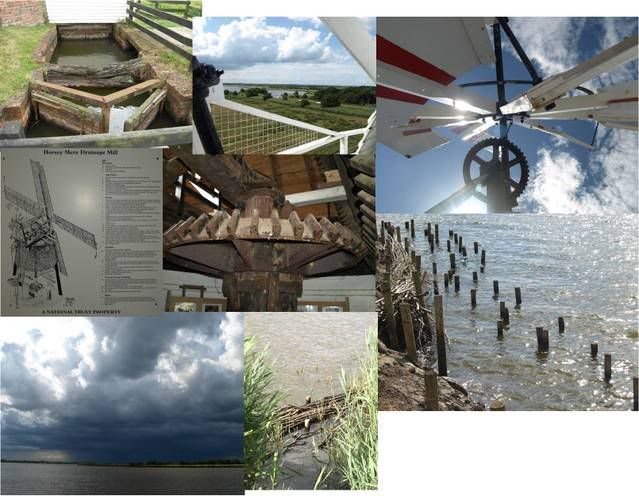

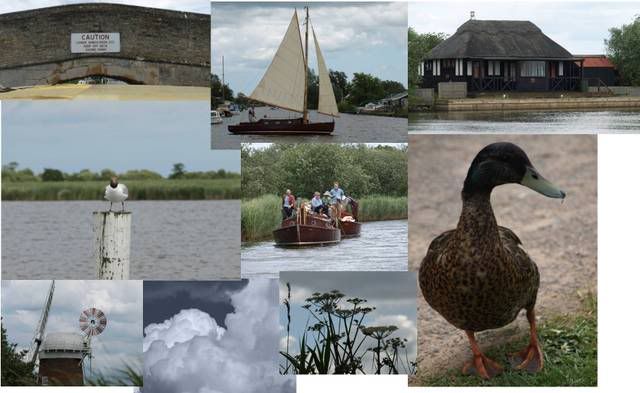
Day Nine: Horsey to Hickling. A short trip, mostly within the nature reserve. An evening spent experimenting with cameras...
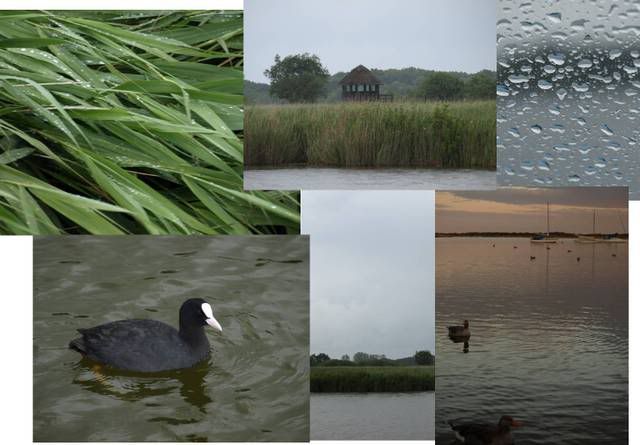
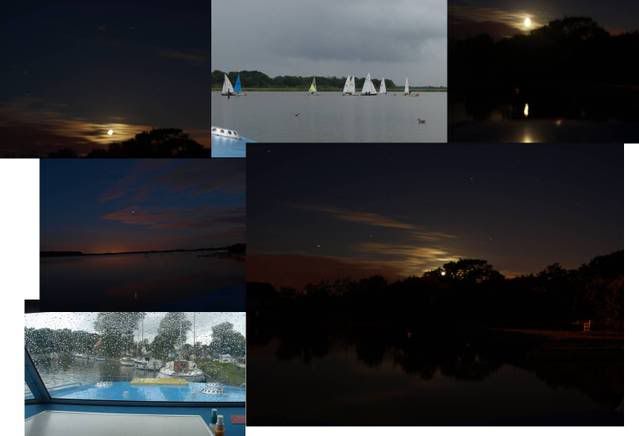
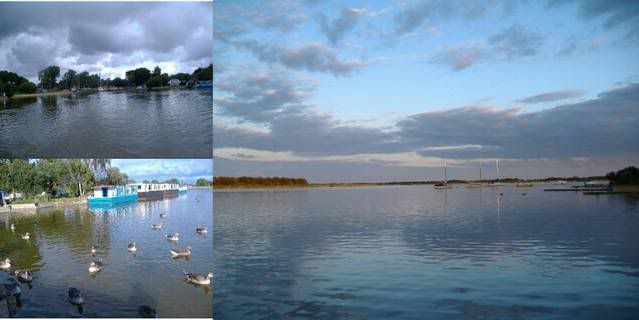



Day Eight: Potter Heigham to Horsey Mill. The pilot has to take you through the bridge, which is quite a relief, given the low clearance.... Horsey Mill is National Trust - shore party went exploring!



Day Nine: Horsey to Hickling. A short trip, mostly within the nature reserve. An evening spent experimenting with cameras...



A'Broad - days four to six......
Day Four: My Birthday!: Stokesby through the tides of Great Yarmouth to Beccles. Very carefully planned, and rather hair-raising! You have to cross Breydon Water, which is large and sea-like.....following this, at breakfast, I got my present - telephoto lens!!!


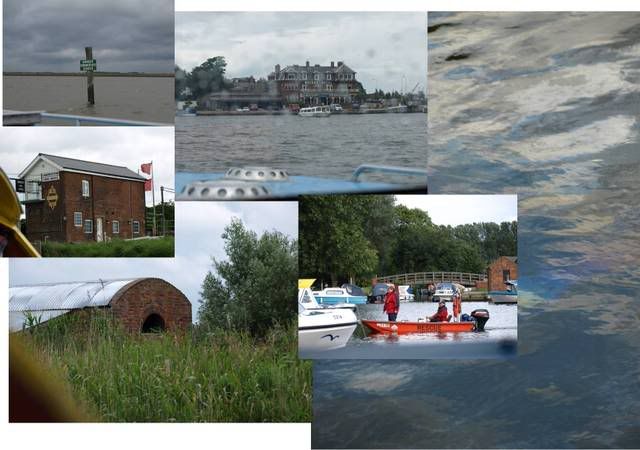
Day Five: Beccles to Brundall. Slumming it amongst the big posh cruisers....


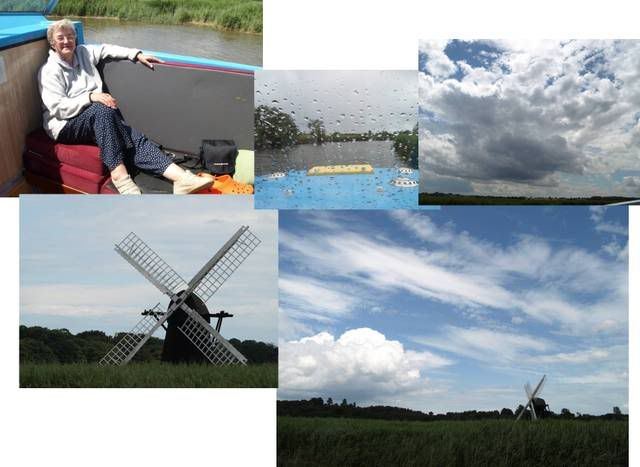
Day Six: upriver from Brundall to the middle of Norwich, (which, unlike Birmingham last year, doesn't seem to want folks to access it from the river - it likes riverside cafes, but you can't visit if you're on a boat!) and back down to the lonely windmill and pub at Berney Arms (one of those places you can't get to with a car)- which is a great place, with some terrific folks in charge!

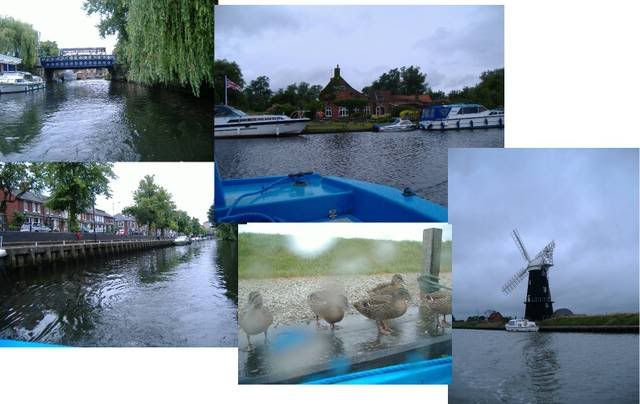
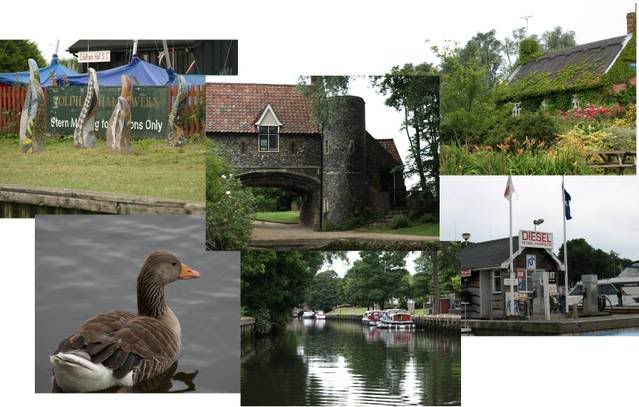
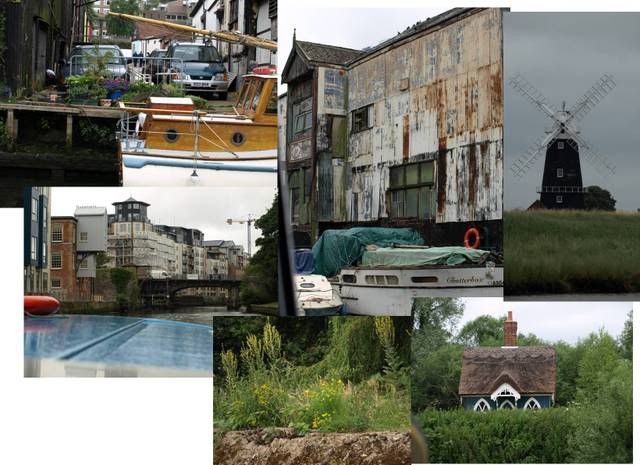



Day Five: Beccles to Brundall. Slumming it amongst the big posh cruisers....



Day Six: upriver from Brundall to the middle of Norwich, (which, unlike Birmingham last year, doesn't seem to want folks to access it from the river - it likes riverside cafes, but you can't visit if you're on a boat!) and back down to the lonely windmill and pub at Berney Arms (one of those places you can't get to with a car)- which is a great place, with some terrific folks in charge!




Abroad on the Broads - day one to three.
I have been reminded by she-who-must-be-obeyed-occasionally that I haven't written anything about our summer holiday....so for those who haven't seen it yet, here we go.
The Family set sail from Stalham, to explore the Norfolk Broads for 10 days or so..... some of the pictures are composites, made up from photos taken by all three of us.
Day One: Stalham to How Hill/Turf Fen Drainage Mill - we picked the boat up in the afternoon, and after some quick instruction, made our way south of Barton Broad to the gorgeous mill at How Hill. The most wonderful sunset...
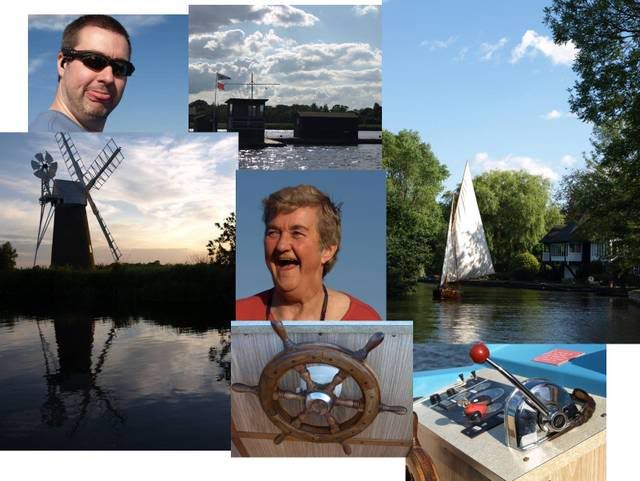
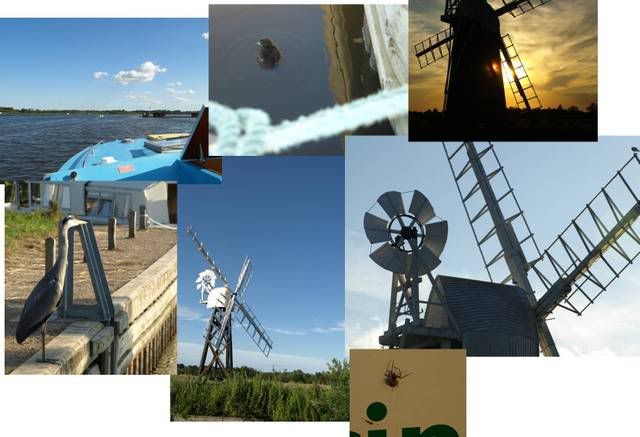
Day Two: How Hill to Coltishall via Horning and Wroxham - revisiting old haunts, the area around Coltishall, where I spent almost 3 years of my life. We had to get the pilot to take us through the bridge at Wroxham - thank goodness!!
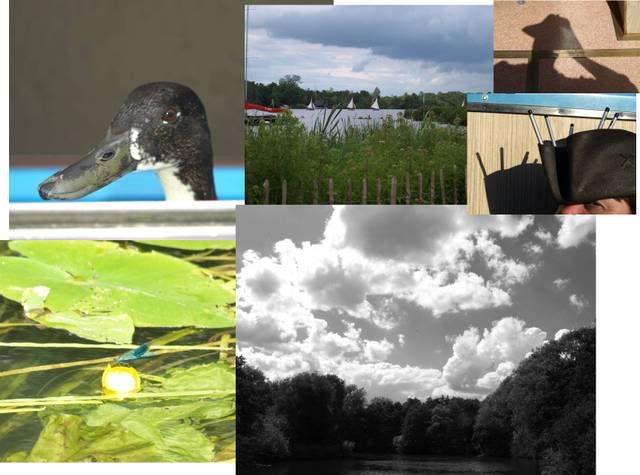

Day Three: Coltishall to Stokesby - we'd hoped to moor up at Acle overnight to head down to Yarmouth (the navigation from North to South Broads requires careful planning to go with the slack of the tide) but the moorings were full, so we ended up further downstream. No problem, though we met some right idiots in the process...
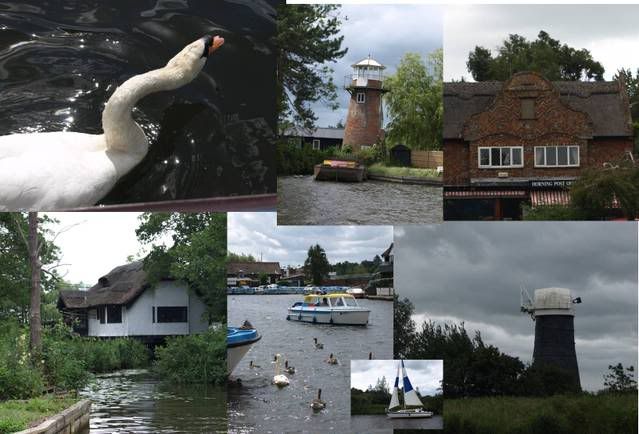

The Family set sail from Stalham, to explore the Norfolk Broads for 10 days or so..... some of the pictures are composites, made up from photos taken by all three of us.
Day One: Stalham to How Hill/Turf Fen Drainage Mill - we picked the boat up in the afternoon, and after some quick instruction, made our way south of Barton Broad to the gorgeous mill at How Hill. The most wonderful sunset...


Day Two: How Hill to Coltishall via Horning and Wroxham - revisiting old haunts, the area around Coltishall, where I spent almost 3 years of my life. We had to get the pilot to take us through the bridge at Wroxham - thank goodness!!


Day Three: Coltishall to Stokesby - we'd hoped to moor up at Acle overnight to head down to Yarmouth (the navigation from North to South Broads requires careful planning to go with the slack of the tide) but the moorings were full, so we ended up further downstream. No problem, though we met some right idiots in the process...


Web Rage
So I’m sat in the car outside the chip shop, waiting for Mum to emerge with our supper, when I notice that, stretched between the wing mirror and the side of the window of my door, are two spiderwebs, one slung behind the other as if to catch prey if the first breaks. Ingenious, I think. A rather rotund spider is wandering about on the one nearest the car, checking for midgies; it finds one, and hastens back into the left side of the recess behind the mirror to have its own supper.
Halfway along the top, a pair of wee spindly legs pokes out, and a much smaller spider emerges, very hesitantly. It steps out onto the second web, exploring. Well, that explains the ‘double web’ I think.
Suddenly, from the right hand side of the mirror, another larger spider rushes out onto the web. Obviously, the small spider’s footsteps have set the web thrumming, alerting the other to the presence of Something For Tea. Small spider freezes at the sight of the bigger one, which advances slowly and menacingly. I begin to think there will be carnage…
Smallest spider makes a dash for the top of the mirror.
Bigger spider goes in pursuit, and it looks like it will soon catch up. I’m almost biting my nails, willing the small one to go faster. It reaches the top and with true spidery ingenuity, flings itself off over the back, abseiling rapidly down the finest of thread to dangle six inches below the mirror, out of sight of the bigger spider. Perplexed (I don’t think the bigger spider is particularly intelligent) the latter seems to shrug, and heads back to its own side of the mirror, vanishing into the gap behind the glass.
Small spider dangles in the wind for a while, a little like Indiana Jones on the broken rope bridge, before clambering back up to the wing mirror and cautiously tiptoeing past the others to its own lurking spot.
Mum wonders why I’m chuckling.
Halfway along the top, a pair of wee spindly legs pokes out, and a much smaller spider emerges, very hesitantly. It steps out onto the second web, exploring. Well, that explains the ‘double web’ I think.
Suddenly, from the right hand side of the mirror, another larger spider rushes out onto the web. Obviously, the small spider’s footsteps have set the web thrumming, alerting the other to the presence of Something For Tea. Small spider freezes at the sight of the bigger one, which advances slowly and menacingly. I begin to think there will be carnage…
Smallest spider makes a dash for the top of the mirror.
Bigger spider goes in pursuit, and it looks like it will soon catch up. I’m almost biting my nails, willing the small one to go faster. It reaches the top and with true spidery ingenuity, flings itself off over the back, abseiling rapidly down the finest of thread to dangle six inches below the mirror, out of sight of the bigger spider. Perplexed (I don’t think the bigger spider is particularly intelligent) the latter seems to shrug, and heads back to its own side of the mirror, vanishing into the gap behind the glass.
Small spider dangles in the wind for a while, a little like Indiana Jones on the broken rope bridge, before clambering back up to the wing mirror and cautiously tiptoeing past the others to its own lurking spot.
Mum wonders why I’m chuckling.
Saturday, 20 September 2008
Things go better with Shell
Driving down the road to the garden centre, to buy some sticks to use in making a game about migration (don’t ask, it’d take longer than I have to explain), I had the strangest feeling I wasn’t alone. Glancing to my left, I realised there was something on the passenger-side window. Somewhere in the night, an adventurous snail had dropped out of the fuchsia bush that overhangs my garden wall and had been exploring the car. Not noticing the inquisitive wee soul, I’d set off and was happily bowling along at around 50 mph. My unexpected passenger seemed somewhat alarmed by this – no doubt it was the fastest he’d ever travelled, for although my snails are no slowcoaches (watch them head up the wall to the chimney on disco night) they lack wheels.
With another car behind me, it wasn’t possible to stop and leave the freeloader in a convenient hedgerow, so I willed him to hang on and we’d part company at the garden centre. He seemed to take heart from this, and started to explore the window, riding along with his wee feelers blowing in the breeze. Up to the top, and halfway down, sticking to the glass by sheer force of will and a sticky foot.
I tried to keep an eye on him, but after coming close to the verge a few times decided that his fate was in the lap of whatever small gods snails have, and concentrated on my driving.
We made it to the garden centre, both unscathed, and I contemplated finding a suitable flowerbed and setting him down in safety there… then I thought again. Garden Centres are not known for their friendship with those of a shelly persuasion, and in leaving him there, may well be condemning him to an early demise. After his tenacity, and plucky determination, I felt this was not something I could be party to, and suggested to him that if he was still on board when I came out of the centre, I would drop him off in the leafy haven of the lay-by just north of the village.
When I came out, he had wandered down to the wing mirror, and was making cautious investigations of the spiderwebs. (Of the spider who lives behind the mirror, there was no sign – obviously reluctant to get involved with one with so many fewer legs than herself). Well, hang on and we’ll soon have you sorted, I said, wondering if anyone was listening to me talking to my wing mirror.
There was a lorry in the lay-by, and no room to pull in behind it. Snail had climbed higher, over the door pillar and onto the corner of the windscreen… less likely to be blown off, I thought, and watched him from the corner of my eye as he clung on like some out-of-place hood ornament, feelers still extended in curiosity at the speed.
So I took him to work.
If you’re still there at the end of the day, I’ll try and take you home, I said, as I got out and unlocked the office door. But you’ll have to be patient – I have to do some shopping and I can’t guarantee what may happen in Tesco’s car-park.
Some six hours later, I emerged to find that he’d settled down for a snooze at the edge of the windscreen, where there’s a bit of a lip that offered some security. Wise lad, I thought. Hang on, here we go again. A seasoned traveller by now, he didn’t even stir as we set off, and remained tucked down and shell-bound all the way.
I guessed he’d had enough of the travelling life when I found him still in the same place after I’d done the shopping. I guess people don’t look closely at the cars when they’re parked – nobody seems to have noticed my car was customised.
So we came home, and after unloading, I carefully lifted him from the windscreen and placed him back in the fuchsia bush. I think he was still snoring. I wondered what he’d think when he woke up – do snails dream of speed, like humans do of flying? And would I know him again, if I saw him sprinting up the wall one rainy night, on his way to the chimney pot?
With another car behind me, it wasn’t possible to stop and leave the freeloader in a convenient hedgerow, so I willed him to hang on and we’d part company at the garden centre. He seemed to take heart from this, and started to explore the window, riding along with his wee feelers blowing in the breeze. Up to the top, and halfway down, sticking to the glass by sheer force of will and a sticky foot.
I tried to keep an eye on him, but after coming close to the verge a few times decided that his fate was in the lap of whatever small gods snails have, and concentrated on my driving.
We made it to the garden centre, both unscathed, and I contemplated finding a suitable flowerbed and setting him down in safety there… then I thought again. Garden Centres are not known for their friendship with those of a shelly persuasion, and in leaving him there, may well be condemning him to an early demise. After his tenacity, and plucky determination, I felt this was not something I could be party to, and suggested to him that if he was still on board when I came out of the centre, I would drop him off in the leafy haven of the lay-by just north of the village.
When I came out, he had wandered down to the wing mirror, and was making cautious investigations of the spiderwebs. (Of the spider who lives behind the mirror, there was no sign – obviously reluctant to get involved with one with so many fewer legs than herself). Well, hang on and we’ll soon have you sorted, I said, wondering if anyone was listening to me talking to my wing mirror.
There was a lorry in the lay-by, and no room to pull in behind it. Snail had climbed higher, over the door pillar and onto the corner of the windscreen… less likely to be blown off, I thought, and watched him from the corner of my eye as he clung on like some out-of-place hood ornament, feelers still extended in curiosity at the speed.
So I took him to work.
If you’re still there at the end of the day, I’ll try and take you home, I said, as I got out and unlocked the office door. But you’ll have to be patient – I have to do some shopping and I can’t guarantee what may happen in Tesco’s car-park.
Some six hours later, I emerged to find that he’d settled down for a snooze at the edge of the windscreen, where there’s a bit of a lip that offered some security. Wise lad, I thought. Hang on, here we go again. A seasoned traveller by now, he didn’t even stir as we set off, and remained tucked down and shell-bound all the way.
I guessed he’d had enough of the travelling life when I found him still in the same place after I’d done the shopping. I guess people don’t look closely at the cars when they’re parked – nobody seems to have noticed my car was customised.
So we came home, and after unloading, I carefully lifted him from the windscreen and placed him back in the fuchsia bush. I think he was still snoring. I wondered what he’d think when he woke up – do snails dream of speed, like humans do of flying? And would I know him again, if I saw him sprinting up the wall one rainy night, on his way to the chimney pot?
Monday, 11 February 2008
Wind of Change
So what gives with this weird weather? It’s been odd for the last four years or so – and where it’s becoming noticeable is with the geese. Today was the regular goose count – normality (for some ten years or so) for January and February has been around 8,000. Regular wintering population in the area. They don’t tend to start building up for another month or so, on their way back to the breeding area in Iceland. But last year, January ran to 20,000, dropping back to normal in February, and this year January was around 18,000 and today we checked in about 24,500… now January can be accounted for in that there was horrible weather in the Central Belt, so we probably hadtheir geese, from Vane Farm and Montrose Basin, and maybe even from further south, Morecambe Bay and even the Wash. But it hasn’t been so bad in the last week or so – so where have they all come from? They don’t seem to stick around during the day; the reserve staff were surprised to see so many. And it isn’t our counting – if anything we undercounted – I was on my own on the usual station, and dealing with a wide front of geese all at once, so if I missed some it wouldn’t have been surprising. (even us old hands get ‘augh, me head's on fire’ moments!)
So what’s with the weather?
The first flying thing I saw this morning, once it stopped being impenetrably dark, was a midge. It was not alone. This is February, for gods’ sake – we shouldn’t have midgies!!! The roe deer, and most of the ducks, are getting frisky – this is normal….but we should have been freezing our socks off even in our thermal underwear, not boiling gently because of the same! There is even a Little Egret on the reserve, and has been for the last month or so – notionally, a Mediterranean bird!
I’ve lived here since 1985. There is absolutely no doubt in my mind that the weather has changed in that time. Snow has shifted from January to March (ooh, I hope not - there is too much to do in March this year), February has got warmer, November windier, and the whole of the winter wetter and dreicher… I could go on.
We are doing something to the climate, whatever the nay-sayers claim. The Earth has, historically, warmed and cooled; this much is true, it’s all to do with wobbling around its axis, but the speed with which it changes seems to be increasing. We should, apparently, being an inter-glacial period, coming up from the depths of cold and the frost fairs of Olde London, when the Thames froze over, and this much I can accept, but should it be happening so fast we can see it year on year?
Wherever you look, someone is making capital out of ‘climate change,’ ‘global warming,’ (and wouldn’t it sound more ominous as ‘global heating’? Warming sounds far too cosy, to me!) and all the various bells and whistles attached to these emotive phrases. One half says it’s dire and dreadful, and the other half says it’s natural and normal – sit back and enjoy the warmer summers! (And to hell if you’re flooded out!)
But do we really want bluetongue disease in our livestock when the winters stay too mild to kill the insect vectors, and to lose ptarmigan and snow buntings from Cairngorm? All of this seems pretty certain, as far as it goes at the moment. Next come malarial mosquitoes in Kent….
The thing is, we don’t understand exactly what’s going on, and how what we’re doing affects it, all we can say is we are doing something, and it may be too late to stop. But maybe, just maybe, we can slow it down until we know more. One of the arguments against reducing CO2 emissions is that by the time it’s a threat, technology will soon be able to sort the problem out. (Thank you for your insight, Mr GW Bush!) But in a race like this, which one will come first – the technology, or the irrevocable damage? Why can’t we help the developing countries, trying to make progress (and understandably narked when we, from our technologically superior (?) criticise their less-developed technology) by giving them the assistance they need to bypass the ‘bad old days’; is the ‘dog in the manger’ race to economic/monetary supremacy worth our future?
The Earth will survive. It does that, very well. It’s just that, like the dinosaurs, and the trilobites, and the giant dragonflies, we may find it won’t support us any more. And I, for one, don’t blame it.
So what’s with the weather?
The first flying thing I saw this morning, once it stopped being impenetrably dark, was a midge. It was not alone. This is February, for gods’ sake – we shouldn’t have midgies!!! The roe deer, and most of the ducks, are getting frisky – this is normal….but we should have been freezing our socks off even in our thermal underwear, not boiling gently because of the same! There is even a Little Egret on the reserve, and has been for the last month or so – notionally, a Mediterranean bird!
I’ve lived here since 1985. There is absolutely no doubt in my mind that the weather has changed in that time. Snow has shifted from January to March (ooh, I hope not - there is too much to do in March this year), February has got warmer, November windier, and the whole of the winter wetter and dreicher… I could go on.
We are doing something to the climate, whatever the nay-sayers claim. The Earth has, historically, warmed and cooled; this much is true, it’s all to do with wobbling around its axis, but the speed with which it changes seems to be increasing. We should, apparently, being an inter-glacial period, coming up from the depths of cold and the frost fairs of Olde London, when the Thames froze over, and this much I can accept, but should it be happening so fast we can see it year on year?
Wherever you look, someone is making capital out of ‘climate change,’ ‘global warming,’ (and wouldn’t it sound more ominous as ‘global heating’? Warming sounds far too cosy, to me!) and all the various bells and whistles attached to these emotive phrases. One half says it’s dire and dreadful, and the other half says it’s natural and normal – sit back and enjoy the warmer summers! (And to hell if you’re flooded out!)
But do we really want bluetongue disease in our livestock when the winters stay too mild to kill the insect vectors, and to lose ptarmigan and snow buntings from Cairngorm? All of this seems pretty certain, as far as it goes at the moment. Next come malarial mosquitoes in Kent….
The thing is, we don’t understand exactly what’s going on, and how what we’re doing affects it, all we can say is we are doing something, and it may be too late to stop. But maybe, just maybe, we can slow it down until we know more. One of the arguments against reducing CO2 emissions is that by the time it’s a threat, technology will soon be able to sort the problem out. (Thank you for your insight, Mr GW Bush!) But in a race like this, which one will come first – the technology, or the irrevocable damage? Why can’t we help the developing countries, trying to make progress (and understandably narked when we, from our technologically superior (?) criticise their less-developed technology) by giving them the assistance they need to bypass the ‘bad old days’; is the ‘dog in the manger’ race to economic/monetary supremacy worth our future?
The Earth will survive. It does that, very well. It’s just that, like the dinosaurs, and the trilobites, and the giant dragonflies, we may find it won’t support us any more. And I, for one, don’t blame it.
Saturday, 26 January 2008
Waters of Philorth
First public even of the year, and a chilly afternoon on the estuary. We’re doing a joint bird-watching thing, between the Council Rangers, RSPB and my own organisation, looking at what is on the estuary and beach to the west of my village. I guess it’s pretty good, having two nature reserves nearby – this is the ‘lesser’ one, the Local Nature Reserve(LNR). LNRs are a way the local Council can protect anything interesting, and help prevent the constant degradation of habitat that seems to be a feature of our world.
So we set out in a chill wind, enough to bring tears to the eyes. I (being of limited mobility) took up post on the river, to check on whatever turned up on the inland section, while the rest headed over the dunes to the beach and the mouth of the river, braving the wind-whipped sand and sea spray.
It’s a place where people come to walk their dogs, and they were present in abundance – from small jovial terriers to aloof lurchers, juvenile retrievers that growled at me as a ‘new & therefore weird’ person, springer spaniels that leapt into the river with a joyful bark and a constantly wagging tail, senior sheepdogs that try to round everyone else up – the prevalent smell in the cars heading homeward must be ‘wet dog’…
Some of the owners are responsible, cleaning up the mess after their pooches dump last night’s dinner. But many don’t seem to feel it’s a problem – you would think that, coming here day after day, they would notice the build up of dog crap around the site, but they seem to have selective vision. Indeed, a local councillor has been reported as saying ‘Well, the bin isn’t near where my dog does its business.’ Good example, guys.
So the place is pretty much a ‘watch where you walk’ endeavour, and even the responsible owners aren’t entirely blameless – I watched a guy with three dogs on leads and three running loose… the ones on leads he cleaned up after…the others had done their thing before he got to where I was standing, and of course he didn’t know they had dumped by then…I do wish people would be aware of what their animals were doing when not under their immediate control, as this would prevent a lot of confrontation between visitors and managers of sites…
Sigh. Enough of crap. Literally. Just clear it up, that’s my view.
There weren’t too many birds around – gulls, crows, jackdaws – last year, we did this walk a month later and there were quite a lot of waders – but this could have been a factor of the tide.
Today was the day after a high spring tide, and coupled with a lot of recent rain, the estuary was pretty full. You expect the tide to fill, hit the top – slack – and then retreat, but it seems this isn’t the way it goes. Watching the water come and go, using a fence post and several clumps of grass as markers, it became evident that there was much more to it.
The water seemed to go up and down several times, the grass islands flooding and emerging as I watched. What drew my attention to the changes was that I noticed a small mammal making its way across the flow to one of the islands, and then staying there - hiding in plain sight as several dogs went past.
The water slowly rose – eventually there was no more island, and the beastie (which I believe(though I wouldn’t bet my life on it!) was a was a water vole –a rarity these days) made its way to the ‘mainland’- chin up and doggy-paddle, determinedly – to the bank.
While I watched, (being interested in the relatively rare sighting) I became aware that the water levels were rising and falling, almost as if the river and the sea were breathing in and out as it hit the top of the tide…the post in the water emerged, snagged trailing debris and then disappeared, releasing the raft of reeds to drift away downstream. Then it appeared again, my attention drawn that way by the loud ‘plop’ of a little grebe making its way downstream on the tide and diving as it went. Up and down. Islands emerging and drowning. Tides are a much more complex thing than they seem, written down in the black and white of tables.
We all met up again, to swap sightings and comments on the weather. The wind whispered in the reeds, dry stems rattling, and a blue tit foraged amongst the foliage for insects and seeds. A flock of jackdaws took wing over our heads, and, distant and clear, the call of pink-footed geese rang clear on the air. Grey skies and cold winds, and the edge of a rain shower, brought an end to our survey.
So we set out in a chill wind, enough to bring tears to the eyes. I (being of limited mobility) took up post on the river, to check on whatever turned up on the inland section, while the rest headed over the dunes to the beach and the mouth of the river, braving the wind-whipped sand and sea spray.
It’s a place where people come to walk their dogs, and they were present in abundance – from small jovial terriers to aloof lurchers, juvenile retrievers that growled at me as a ‘new & therefore weird’ person, springer spaniels that leapt into the river with a joyful bark and a constantly wagging tail, senior sheepdogs that try to round everyone else up – the prevalent smell in the cars heading homeward must be ‘wet dog’…
Some of the owners are responsible, cleaning up the mess after their pooches dump last night’s dinner. But many don’t seem to feel it’s a problem – you would think that, coming here day after day, they would notice the build up of dog crap around the site, but they seem to have selective vision. Indeed, a local councillor has been reported as saying ‘Well, the bin isn’t near where my dog does its business.’ Good example, guys.
So the place is pretty much a ‘watch where you walk’ endeavour, and even the responsible owners aren’t entirely blameless – I watched a guy with three dogs on leads and three running loose… the ones on leads he cleaned up after…the others had done their thing before he got to where I was standing, and of course he didn’t know they had dumped by then…I do wish people would be aware of what their animals were doing when not under their immediate control, as this would prevent a lot of confrontation between visitors and managers of sites…
Sigh. Enough of crap. Literally. Just clear it up, that’s my view.
There weren’t too many birds around – gulls, crows, jackdaws – last year, we did this walk a month later and there were quite a lot of waders – but this could have been a factor of the tide.
Today was the day after a high spring tide, and coupled with a lot of recent rain, the estuary was pretty full. You expect the tide to fill, hit the top – slack – and then retreat, but it seems this isn’t the way it goes. Watching the water come and go, using a fence post and several clumps of grass as markers, it became evident that there was much more to it.
The water seemed to go up and down several times, the grass islands flooding and emerging as I watched. What drew my attention to the changes was that I noticed a small mammal making its way across the flow to one of the islands, and then staying there - hiding in plain sight as several dogs went past.
The water slowly rose – eventually there was no more island, and the beastie (which I believe(though I wouldn’t bet my life on it!) was a was a water vole –a rarity these days) made its way to the ‘mainland’- chin up and doggy-paddle, determinedly – to the bank.
While I watched, (being interested in the relatively rare sighting) I became aware that the water levels were rising and falling, almost as if the river and the sea were breathing in and out as it hit the top of the tide…the post in the water emerged, snagged trailing debris and then disappeared, releasing the raft of reeds to drift away downstream. Then it appeared again, my attention drawn that way by the loud ‘plop’ of a little grebe making its way downstream on the tide and diving as it went. Up and down. Islands emerging and drowning. Tides are a much more complex thing than they seem, written down in the black and white of tables.
We all met up again, to swap sightings and comments on the weather. The wind whispered in the reeds, dry stems rattling, and a blue tit foraged amongst the foliage for insects and seeds. A flock of jackdaws took wing over our heads, and, distant and clear, the call of pink-footed geese rang clear on the air. Grey skies and cold winds, and the edge of a rain shower, brought an end to our survey.
Thursday, 3 January 2008
Swan Lake
Winter, for me, starts officially with the return of the whooper swans from Iceland.
One of the best places to see them is Welney, a Wildfowl and Wetlands Trust reserve on the Ouse Washes near Ely, so on a chilly, damp day in November ‘07, Mum and I headed down there to visit them; an afternoon feeding session guarantees a good turnout!
The Visitor Centre is new since the last time we were there – it’s very eco-friendly, with a reed-bed water-treatment system, and an excellent café.


Crossing the bridge, you reach the hide – well, I call it a hide, but it’s centrally heated and far more comfortable than any hide has a right to be. It looks out across the flooded Washes – watermeadows that take the brunt of the winter’s rainfall, and managed to provide an ideal habitat for the migrating wildfowl and for summer visitors in their turn. There are three types of swan here – mute swans, whoopers, and the smaller Bewick swans, although the latter don’t come in close, being kept off the grain feed by the other, bigger birds. (At the moment there is also a black swan, an escape from a local collection and rather unexpected!) As well as swans, there are any numbers of ducks. Most of the ones close-in are mallard (the usual village pond ducks) and pochard – these are the rather dapper grey and chestnut chaps.
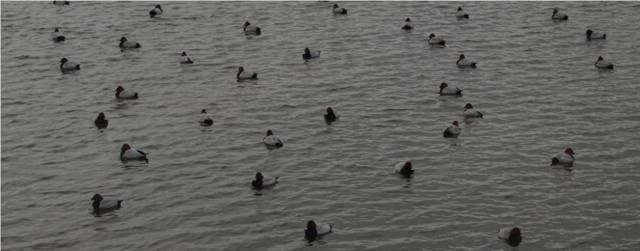
Duck Fact: And they are nearly all chaps… the males leave the nesting grounds earlier than the females and young, and consequently take the northerly wintering sites, making the females go further south to Spain. (Hardship, girls!!) The males head back to the breeding grounds in Scandinavia at the start of the season, taking up territories ready for the arrival of the females who, of course, have further to come. The boys bustle around, jockeying for position to be in the right place when the warden comes with the grain barrow, prodding and pushing, diving down and popping up, often underneath an indignant swan, with a flurry of bubbles and a shuffle of feathers and a quick dash to avoid an indignant swan beak. The mallard don’t tend to dive, and have their females with them. They are more inclined to simply shove each other aside in the general melee.

As the light dims the swans start to arrive in greater numbers – up to 4,000 of them at the moment – and they start to parade back and forth in front of the hide, all competing for the right to be first at the food. Below us, the floodlights go on, and excitement builds amongst the birds. A sudden rush to the right alerts us to the warden with his barrow of grain; he makes his way along in front of us, casting scoops of grain into the water. All dignity amongst the swans is immediately lost, and the ducks become a feathered frenzy.
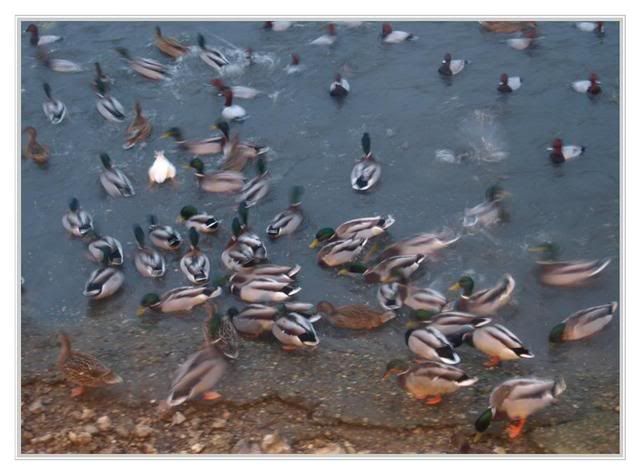
Twilight descends, and with it more swans, white shapes in the gloaming winging over our heads with a melodious and melancholy whooping song, slipping down the cold evening air onto the water, greeting each other with bobbing heads and touching beaks, small family groups – parents and this year’s ashy grey young – staying together amidst the growing flock. We stay until it is too dark to see any more, then take the road northwards, to home and bed.
Winter’s here.
One of the best places to see them is Welney, a Wildfowl and Wetlands Trust reserve on the Ouse Washes near Ely, so on a chilly, damp day in November ‘07, Mum and I headed down there to visit them; an afternoon feeding session guarantees a good turnout!
The Visitor Centre is new since the last time we were there – it’s very eco-friendly, with a reed-bed water-treatment system, and an excellent café.


Crossing the bridge, you reach the hide – well, I call it a hide, but it’s centrally heated and far more comfortable than any hide has a right to be. It looks out across the flooded Washes – watermeadows that take the brunt of the winter’s rainfall, and managed to provide an ideal habitat for the migrating wildfowl and for summer visitors in their turn. There are three types of swan here – mute swans, whoopers, and the smaller Bewick swans, although the latter don’t come in close, being kept off the grain feed by the other, bigger birds. (At the moment there is also a black swan, an escape from a local collection and rather unexpected!) As well as swans, there are any numbers of ducks. Most of the ones close-in are mallard (the usual village pond ducks) and pochard – these are the rather dapper grey and chestnut chaps.

Duck Fact: And they are nearly all chaps… the males leave the nesting grounds earlier than the females and young, and consequently take the northerly wintering sites, making the females go further south to Spain. (Hardship, girls!!) The males head back to the breeding grounds in Scandinavia at the start of the season, taking up territories ready for the arrival of the females who, of course, have further to come. The boys bustle around, jockeying for position to be in the right place when the warden comes with the grain barrow, prodding and pushing, diving down and popping up, often underneath an indignant swan, with a flurry of bubbles and a shuffle of feathers and a quick dash to avoid an indignant swan beak. The mallard don’t tend to dive, and have their females with them. They are more inclined to simply shove each other aside in the general melee.

As the light dims the swans start to arrive in greater numbers – up to 4,000 of them at the moment – and they start to parade back and forth in front of the hide, all competing for the right to be first at the food. Below us, the floodlights go on, and excitement builds amongst the birds. A sudden rush to the right alerts us to the warden with his barrow of grain; he makes his way along in front of us, casting scoops of grain into the water. All dignity amongst the swans is immediately lost, and the ducks become a feathered frenzy.

Twilight descends, and with it more swans, white shapes in the gloaming winging over our heads with a melodious and melancholy whooping song, slipping down the cold evening air onto the water, greeting each other with bobbing heads and touching beaks, small family groups – parents and this year’s ashy grey young – staying together amidst the growing flock. We stay until it is too dark to see any more, then take the road northwards, to home and bed.
Winter’s here.
Subscribe to:
Posts (Atom)
